|
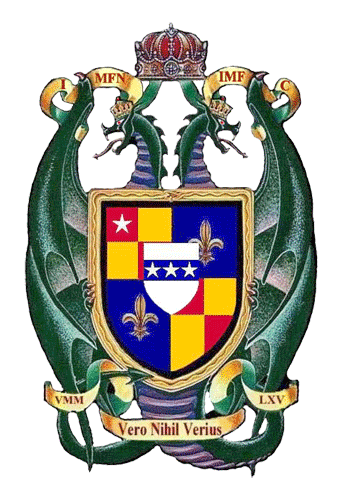



from
Dagobert's Revenge Website
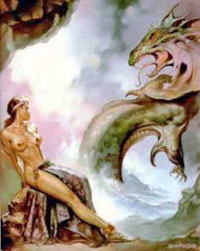 Introduction Introduction
“The Beast, the
Dragon, the terrible monster, is the disguise of the beloved;
the horror to be overcome itself is, or contains, the Reward.
Beauty and the Beast must be conjoined. The old tag that a
serpent becomes not a Dragon save by devouring another serpent,
has an Alchemical sense:
These are the
two Dragons, male and female: they destroy one another, or
one destroys the other and a new and mightier one is born, a
fiery wonder: A Phoenix
*
, a leaping glory, a STAR of dream ascending to the throne
of the world. This was the Transmutation, the Great Work of
the hidden glory of perfection”.
Arthur Machen,
Fr.GD.
(Frater of the Hermetic Order of the Golden Dawn).
The mating of Ravens is
the rhythmic inhalation and exhalation of the breath of Ravens, one
by the other. And in this way are the children of Ravens fashioned.
(The Raven is the Phoenix of the Elven Kings).
Traditional country
folklore
( England)
*
The red and gold
tinctures and metals on the field of their heraldic escutcheon,
[traditionally symbolizing the plumage of the Phoenix] superimposed
by the White Star – literally the falling star of Lucifer – are the
Arms of the Vere and reflect their ancient line of descent from
Sathaniel or the Devil. The escutcheon, supported by two dynastic,
hermetic Dragons becomes, historically, the Ancient Alchemical Seal
of the House. The Phoenix of the Scythians was the Raven. The Raven
itself, or rather the double-headed Raven found in Transylvania,
devolved down to the Hittites and from them it was eventually
adopted and modified as the double-headed black Eagle of the Holy
Roman Empire.
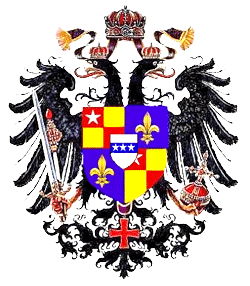
Editor's Notes
In the following material the reader will find that the genealogical
descent is interspersed with blocks of information. These are
included to give greater background to the document. In this added
information the reader will also find repetitions of the same
material. These repetitions are gathered from a wide variety of
sources and are included here together to act as corroboration, one
source with the other.
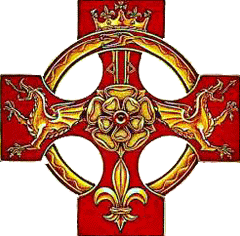
Published comments
concerning the House of Vere
Vere-de-Vere stalked into the English vernacular as a playful term
meaning the grandest, proudest, most historic, indisputably
aristocratic and absolutely creme de la creme of Anglo-'Norman'
antiquity.
In fiction the expression is used for characters of, or assuming,
unquestionable ancient lineage - and with good cause.
In the Middle Ages, owing to plagues and battlefield mortality, the
average noble dynasty in England lasted not more than three
generations. The de Veres, however, managed to maintain a line of
twenty earls of Oxford over 561 years*.
(*Our note: The senior descents in the male line today reach back
One Thousand Three Hundred Years).
Lord Thomas Macaulay, Victorian historian supreme calls this family:
"The longest and
most illustrious line of nobles that England has
seen..........the noblest House in Europe".
Vero Nihil Verius
(nothing truer than truth) is the family motto granted by Queen
Elizabeth I. The family crest was already the Blue Boar.
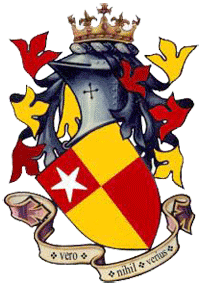 The Falling Star of Vere The Falling Star of Vere
A legend lingers round the acquisition of the de Vere (star) badge.
In the version as told by Leland, Aubrey was 'at the Conquest of the
Cities of Nicque, of Antioch, and of Hierusalem' and:
"In the year of our
lord 1098, Corborant, Admiral to the Soudan of Persia was fought
with at Antioch, and discomforted the Christians. The Night
coming on in the Chace of this Bataile, and waxing dark, the
Christianes being four miles from Antioche, God, willing the
saufte of the Christianes shewed a white Starre or Molette of
fyve Pointes, which to every Manne's Sighte did lighte and
arrest upon the standard of Albrey, then shining excessively".
The mystic star from
this miracle became the de Veres' badge, which they wore on their
shields from then onwards - quarterly gules and or, in the first
quarter a mullet argent. Later heralds argued that it was merely 'a
mullet with a difference' as always used to distinguish a younger
son from an elder. Others said that it was not a star at all, but
the rowl spur, from the French word mollet, which could have been
held up as a pre~arranged sign to muster supporters and was caught
in a ray of sunlight. "But for the de Veres the badge was simply
"God" pointing out the family's near~deity".
From Verily Anderson,
'The Veres of Castle Hedingham'.
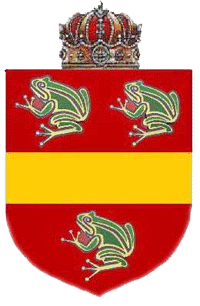
The House of Vere
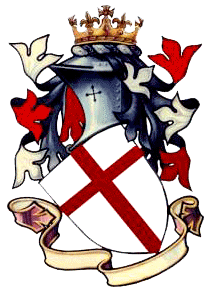
"The noblest subject
in England, and Indeed, as Englishmen loved to say, the noblest
subject in Europe, was Aubrey de Vere........who derived his
title through an uninterrupted male descent, from a time when
the families of Howard and Seymour were still obscure, when the
Nevills and Percys enjoyed only a provincial celebrity, and when
even the great name of Plantagenet had not yet been heard in
England. One chief of the house of de Vere had held high command
at Hastings; another had marched, with Godfrey and Tancred, over
heaps of slaughtered Moslems, to the sepulchre of Christ. The
first Earl of Oxford had been minister of Henry Beauclerc, The
third earl had been conspicuous among the lords who extorted the
great Charter from JOHN. The seventh earl had fought bravely at
Cressy and Poictiers. The thirteenth earl had, through many
vicissitudes of fortune, been the chief of the party of the Red
Rose, and had led the van on the decisive day of Bosworth. The
seventeenth earl had shone at the court of Elizabeth I, and had
won for himself an honourable place among the early masters of
English poetry.........".
Baron Thomas
Babbington Macaulay
Lord Macaulay of
Rothley Temple (1857)
See source profile.
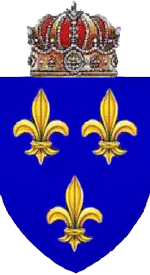
Professor Vivian Greene:
"The Counts of Anjou: Princes of Anjou"
Sir Bernard Burke, Ulster King of Arms,
when speaking of the Vere called them
singularly and in plural:
"The Princely Noble……The Race of Vere"
(Extract from 'Vicissitudes of Families',
page 424 line 12 and page 426 para 2 line 12).
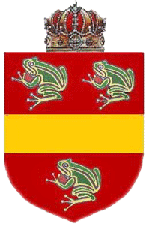
G. E. Cokaynes Complete Peerage Volume X.
Page 208
OXFORD
II. 2.AUBREY (DE VERE) IV, EARL of OXFORD, hereditary Master
Chamberlain of England. 1st s. and h.
by 3rd wife, (a) b. 1163 or later. (b) While still a boy he attested
his father's charters for Colne Priory (c) and a charter of Ranulf
de Mandeville for St. Osyth ; (d) and he witnessed 7 more of his
father's charters for Colne (e) and joined him in attesting a number
of other charters for that priory (f) and 2 other charters. (g)
Early in 1190 he Was with the King in Normandy.(h) He obtained the
Bolebec fief with Isabel the heiress, (i) and together they gave a
tenement in Wavendon to Woburn Abbey. (j) On 21 Feb. , 1190/I he
confirmed his father's foundation of Castle Hedingham Priory, and at
the request of his father and rnother gave it his church at Castle
Hedingham and the wood at Gosfield; (k) but at Michaelmas in that
year he owed 100 marks for what was imposed on his men for burning
the nunnery.(l) Within the years I191-9, he witnessed a charter of
John, Count of Mortain (afterwards King), for Rouen Cathedral. (m)
In Dec. 1194 he suc. his father, and in 1195 as Aubrey de Vere
junior, he rendered account for £100 for his relief............
Footnotes
(a) Item in comite Alberico Alberici comitis de Ver filio, simile
naturae miraculum vidimus. Cum enim pater ejusdem, matre jam
Praegnante, filia scilicet Henrici de Essexia, ob ignominiosum
patris eventum jam ad divortium modis omni elaborasset, partu
prodeunte; quem pater in oculo casuali laesione sustinuit, eadem
parte defectus in filio parentavit (Giraldus Cambrensis, OP. cit, p
132). Albericus Comes Oxeneford. His testibus Alberico filio meo et
Herede et Roberto Henrico Filiis meis (Colne Cart., no.42).
(b) There is no proof that his parents did not cohabit between 1163
and ii or 1172; for his mother's age cf p.206, note "e."
(c) His Testibus Alberico filio meo Radulpho de Ver. Radulpho
magistro Alberici (Colne Cart., no.38; cf Idem, no. 45) That Aubrey
had a master proves that he was a boy at the time.

OXFORD
III. 1214. 3. ROBERT (DE VERE), EARL OF OXFORD,
Hereditary Master Chamberlain of England, being 3rd but eldest surv.
S. of the 1st Earl, by 3rd wife.
Footnotes.
(1) His afilliation is proved by his attestations to 4 of his
father's charters Colne, e.g. "His testibus Albrico filio meo et
Roberto fratre ejus" (Colne Q no.46). He has always been described
as the 2nd son, but in the 3 charters for Colne
Priory.................
(2)

OXFORD
Footnotes.
..........................which are witnessed both by Robert and by
his brother Ralph, his name precedes Robert's (Idem, nos. 36, 41,
85).
(a) On the assumption that Robert was the 3rd son; after 1172 if his
parents did not resume cohabitation before I 171. He seems to have
been with his brother Aubrey in Normandy in Aug. 1197 (Landon, op.
cit., pp I20~2I)
See Source Profile.
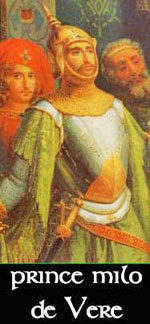
'The Royal Genealogies'
Table CCXVI

Milo de Vere was Count of Anjou before the emergence of the
Plantagenet ancestor Tortulf. In consequence of this fact, The House
of Vere are the senior Counts of Anjou.
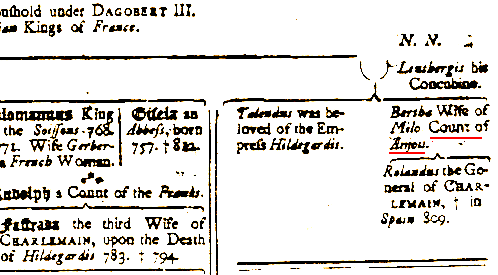
Tabular Section of the above right
Milo: Count of Anjou
( Page 450 'The Royal Genealogies' The Rev. Dr. James Anderson, D.D.,
M.A : Milo I de Vere was Count of Anjou, (hence eldest son of
Melusine/Milouziana de Scythes /Maelasanu: The Elven, Dragon
Princess, neice of the Swan Princess Morgan La Fey de Avallon del
Acqs ).
See Source Profile.

THE MADNESS OF KINGS
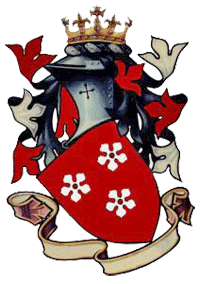 A count of Anjou came back with a new wife, a strange girl of
extraordinary beauty but she kept very much to herself. Unusually in
so religious an age she was reluctant to attend the Mass. When she
did go she always hurried from the church before the consecration of
the host. Her husband, who was puzzled by her behaviour, told four
knights to keep watch and to try to delay her departure from the
church. When she got up to go, one of them trod on the hem of her
train. As the priest raised the host to consecrate it she screamed,
wrenched herself free, and still shrieking, flew out of the window,
taking two of her children with her. In reality the countess was the
wicked fairy, Melusine, the daughter of Satan, who cannot abide the
consecration of the body of Christ in the Mass. It was from the
children that she left behind that the counts of Anjou and the
Angevin kings of England were said to be descended. A count of Anjou came back with a new wife, a strange girl of
extraordinary beauty but she kept very much to herself. Unusually in
so religious an age she was reluctant to attend the Mass. When she
did go she always hurried from the church before the consecration of
the host. Her husband, who was puzzled by her behaviour, told four
knights to keep watch and to try to delay her departure from the
church. When she got up to go, one of them trod on the hem of her
train. As the priest raised the host to consecrate it she screamed,
wrenched herself free, and still shrieking, flew out of the window,
taking two of her children with her. In reality the countess was the
wicked fairy, Melusine, the daughter of Satan, who cannot abide the
consecration of the body of Christ in the Mass. It was from the
children that she left behind that the counts of Anjou and the
Angevin kings of England were said to be descended.
(Of the Plantagenet Branch):
So devilish an ancestry accounted for the demonic energy and
passionate ill-temper by which these princes seemed often afflicted.
'We who came from the devil', John's brother, Richard I, was
reported as saying caustically, 'must needs go back to the devil. Do
not deprive us of our heritage: we cannot help acting like devils.'
'De diabolo venit et ad diabolum ibid', commented St Bernard of
Clairvaux, 'From the devil he came, and to the devil he will go.'
Professor Vivian Greene.
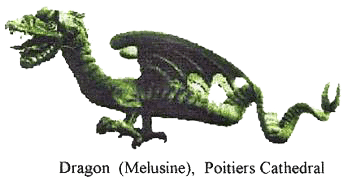
Cependant, apprenant plus tard que Geoffrey a brule l'abbaye de
Maillezais et tue son frere, le Comte maudit son epouse. Il l'acuse
publiquement d'etre "tres fausse serpent". Le secret est devoile.
Melusine doit regagner L'Autre Monde et s'envole transformee en
DRAGON.
Christine Bonnet, Lusignan.

The Duchy of Angiers
Angiers was a Ducal principality in the Comite region of Anjou. In
the work of The Rev. Father Sabine Baring-Gould Angiers is referred
to as the country where the Scottish, Pictish Princess Melusine
eventually became a native after having fled from Avallon. Angiers
is now the city of Angers in northern Anjou. As a Ducal principality
its rulers constituted a regnant royal house who, in the case of the
Vere, were also the Counts of the region in which this 'city state'
was situated.
See Source Profile.
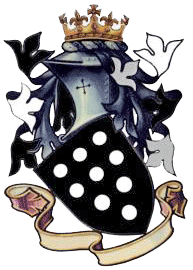 Vere Princedom Vere Princedom
Although Merovingian culture was both temperate and surprisingly
modern, the monarchs who presided over it were another matter. They
(The Sorcerer Kings) were not typical even of rulers of their own
age, for the atmosphere of mystery legend, magic and the
supernatural, surrounded them, even during their lifetimes. If the
customs and economy of the Merovingian world did not differ markedly
from others of the period, the aura about the throne and royal
bloodline was quite unique.
Sons of the Merovingian blood were not 'created' kings. On the
contrary they were automatically regarded as such on the advent of
their twelfth birthday. There was no public ceremony of anointment,
no coronation of any sort. Power was simply assumed, as by sacred
right.
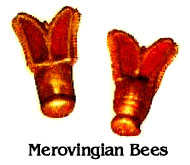 But while the king was supreme authority in the realm, he was not
obliged - or even expected - to sully his hands with the mundane
business of governing. He was essentially a ritualised figure, a
priest-king, and his role was not necessarily to do anything, simply
to be. The king ruled in short, but did not govern. But while the king was supreme authority in the realm, he was not
obliged - or even expected - to sully his hands with the mundane
business of governing. He was essentially a ritualised figure, a
priest-king, and his role was not necessarily to do anything, simply
to be. The king ruled in short, but did not govern.
Even after their conversion to Christianity the Merovingian rulers,
like the Patriarchs of the Old Testament, were polygamous. On
occasion they enjoyed harems of oriental proportions. Even when the
aristocracy, under pressure from the Church, became rigorously
monogamous, the monarchy remained exempt. And the Church, curiously
enough, seems to have accepted this prerogative without any
inordinate protest. According to one modern commentator: Why was it
[polygamy] tacitly approved by the Franks themselves?
We may here be in the presence of ancient usage of polygamy in a
royal family - a family of such rank that its blood could not be
ennobled by any match, however advantageous, nor degraded by the
blood of slaves ... It was a matter of indifference whether a queen
were taken from a royal dynasty or from among courtesans...
The fortune of the dynasty rested in its blood and was shared by all
who were of that blood.
And again,
'it is Just possible that, in the Merovingians, we may have a
dynasty of Germanic Heerkonige* derived from an ancient kingly
family of the migration period'.
Extracted and expanded upon by Henry Lincoln, from 'The Long Haired
Kings' by
J. M. Wallace-Hadrill; Fellow of Merton College Oxford.
* Fritz Kern, Gottesgnadentum und Widerstandrecht (1954).
The House of Vere are descended in numerous lines from the
Merovingian dynasty and consequently share in this ancient Germanic
Royal Blood Tradition. Prince Milo de Vere - married to
Charlemagne's sister - and as Head of the Imperial House and Chief
of the Imperial Army, was himself an Imperial Prince.
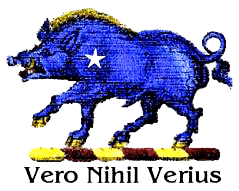
The Descent of the 'Imperial and Royal' House of Vere of Anjou
700 -2000 a.d.
Ex libello Genealogiae Comitum Oxoniensium
Official de Vere family records
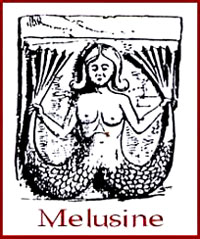
Repetit genus á Noe. Deinde á Tideo Graeco. Insuper á Vero nobilis
Romano Postremo á Milone comite de Genny, alias Gisney (GUISNES).
760+ AD Milo de Ver: Duke of Aungiers and Duke Leader of Great King
Charles house and army (son of Rainfroi: de Ver) - Milo married
Bertbelle, sister of Great King Charles Charlemagne. Merovingian
descent of the House of Vere.
800+ AD Rouland de Ver (son of Milo and Bertbelle): Held the titles
of the "Earl of Palatine", "Earl of Maunce and Bleuys", "Governor of
the Marches of Brittany" however, he was killed by warring Pagans at
Rumcidevale. 800+ AD Baldwine de Ver: became "Duke of Maunce" after
his brother Rouland's death.
800+ AD Milo de Ver II (ii) (son of Milo [i]) Held title of the
"Earl of Genney or Gisney or GHISNES" given to him by Charlemagne,
he married Avelina the daughter to the "Earl of Nauntes" and they
had two sons, Nicasius and Milo(iii).
800+ AD Nicasius (Nicholas/Nissé) de Vere : married Agathe daughter
to the "Earl of Champaign" and gave issue to Otho "de Vere" who
later became the "Earl of Genney".
[ Nicasius de Ver Erle of Genney sonne to yong Milo
Erle of Genney.
This Nicasius had to wyfe Agathe the dowghtar of the
Erle of Champain.
Of Nicasius cam Otho de Vere Erle of Genney, maried to
Constance dowghtar to the Lord of Charters ]
Underlined excerpt from Stow MSS, British Library, London.
800+ AD Otho de Vere: married Constance daughter to the "Lord of the
Charters" and gave issue to Amelius de Ver.
Amelius ("Aldolphus") de Vere: Earl of Genny (GHISNES or GUISNES)
married 1. Maud de Ponthieu and 2. Helena daughter of Earl Bloys
His son by Maud:
Gallus/Guillaume (Guy Blanc Barbe) de Vere: Earl of Genny (GHISNES -
GUISNES) married Gerbrudis daughter to the Lord Cleremont. (Gallus -
Guillaume went with Aubri and the King to England). Descent to
Godfroi de Bouillon and the Counts of Boulogne.
Manasses de Vere: Earl of Genny married Petronilla daughter of the
Earl of Boleine.
Their son:
Alphonsus (Alberic) I de Vere: Earl of Genney, Count of Ghesnes (Genny,
alias Gisney or GHISNES or GUISNES) married Katarine daughter to
Arnalde Earl of Flaunders. And was a "Counsellor (earl of the Witan)
to Edward the Confessor".
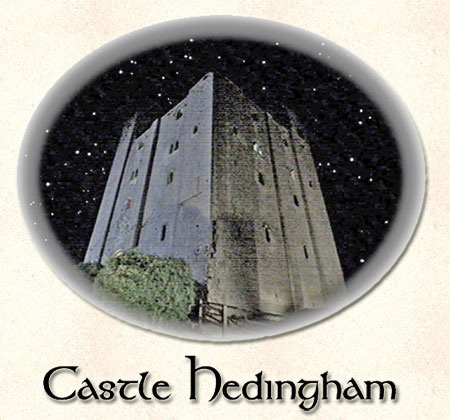

The Vere Earls of Guisnes
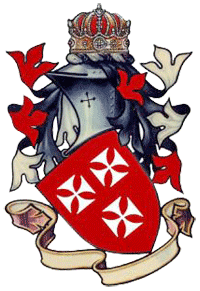 In the matter of the succession of Robert de Vere to the earldom of
Oxford in the In the matter of the succession of Robert de Vere to the earldom of
Oxford in the
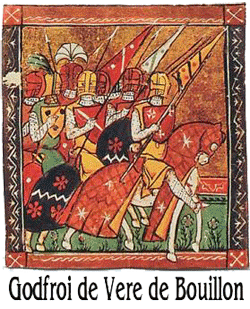 reign of Charles I, the title was contested for by
Lord Willoughby de Eresby. Several Judges of the day were appointed
to guide the Lords in legal matters regarding this succession.
Leading them was the Lord Chief Justice of England, Sir Randolph
Crew. Robert de Vere won the case and the Crown vouchsafed the
earldom of Oxford to him. The summing up speech delivered by the
Lord Chief Justice before the House of Peers (The House of Lords)
was recorded as part of the judicial process (Sir Bernard Burke) and
its comments are therefore part of English Law. reign of Charles I, the title was contested for by
Lord Willoughby de Eresby. Several Judges of the day were appointed
to guide the Lords in legal matters regarding this succession.
Leading them was the Lord Chief Justice of England, Sir Randolph
Crew. Robert de Vere won the case and the Crown vouchsafed the
earldom of Oxford to him. The summing up speech delivered by the
Lord Chief Justice before the House of Peers (The House of Lords)
was recorded as part of the judicial process (Sir Bernard Burke) and
its comments are therefore part of English Law.
On Saturday 1st April 1626 Sir Randolph Crew addressed their
Lordships saying:
"This great and weighty cause, incomparable to any other that hath
happened at any time, requires great deliberation, and solid and
mature judgement to determine it, and I wish that all the judges of
England had heard it - it being a fit case for all - to the end we
all might have given our humble advice to your Lordships herein.
Here is represented to your Lordships certamen honoris, and, as I
may well say, illustris honoris, illustrious honour. I heard a great
peer of this realm, and a learned, say, when he lived there was no
king in Christendom had such a subject as Oxford.
He came in with the Conqueror, Earl of Guynes; shortly after the
Conquest, made Great Chamberlain of England above five hundred years
ago, by Henry I., the Conqueror's son, brother to Rufus; by Maud,
the Empress, Earl of Oxford; confirmed and approved by Henry II.,
Alberico comiti, so Earl before.
This great honour, this high and noble dignity hath continued ever
since in the remarkable surname of De Vere, by so many ages,
descents and generations, as no other kingdom can produce such a
peer in one and the self-same name and title.................And yet
let the name and dignity of De Vere stand for so long as it pleaseth
God"
That the Vere were Earls of Guisnes before 1066 is recognised by
British law.
With thanks to Miss C. Shelton; the House of Lords Archivist, for
the primary sources consulted.
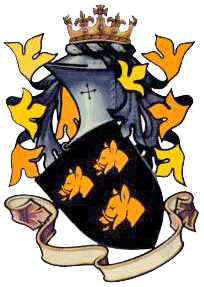 1000+ Albery II de Vere: Earl of Genney wed - Beatrice Sister to
King William the Conqueror: Vere descent from the Merovingian
dynasty. Alberic went with the King to England. He used the
motto,"Albri Comes" which some say is "Albery of truth cometh", de
-of ; Ver- true. But Comes simply means Count. Albery is also Aubri,
Albury, Alberic (in Latin); Alphonsus (in Greek). He built "Hedingham
Castle". At the time of the general survey, Alberic de Ver was
already noted as a person of ancient and noble descent (Domesday
Book). Leland, stated or deduced that the pedigree of this family
was from "Noah", Meleager, who slew the Caledonian boar, and
Diomedes, who was at the seige of Troy.- N.B. Caesar and
Charlemagne. 1000+ Albery II de Vere: Earl of Genney wed - Beatrice Sister to
King William the Conqueror: Vere descent from the Merovingian
dynasty. Alberic went with the King to England. He used the
motto,"Albri Comes" which some say is "Albery of truth cometh", de
-of ; Ver- true. But Comes simply means Count. Albery is also Aubri,
Albury, Alberic (in Latin); Alphonsus (in Greek). He built "Hedingham
Castle". At the time of the general survey, Alberic de Ver was
already noted as a person of ancient and noble descent (Domesday
Book). Leland, stated or deduced that the pedigree of this family
was from "Noah", Meleager, who slew the Caledonian boar, and
Diomedes, who was at the seige of Troy.- N.B. Caesar and
Charlemagne.
Alberic held a number of lordships in several counties in England
and particularly 14 in Essex; where Hedingham was his castle, chief
seat and caput or head of his barony.
This Alberic, the second styled Aberico senior, took the habit of a
monk; and was buried in the church of Colne priory, which he had
founded.
Albericus III, Junior, was successor to his father; and became so
much in favor with Henry I that the said King made him great
"Chamberlain of England", in fee;
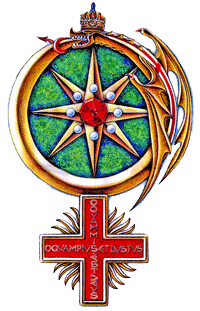
(click image to
enlarge)
Patent extracts:
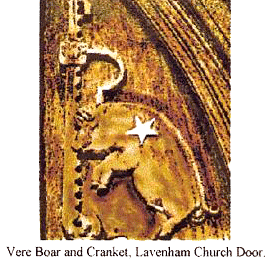 "H Rex Anglrorum, &c. Sciatis universi quoniam dedi & concssi
Alberico de Ver & hereib, ' suis post eum de me & meis tenend'
magistram camerarim ,eamtotius Anglie in feode & hereditate quare
volo & firmiter precipio quod ipse & heredes sui eam jure
hereditario teneant cim omnibus dignaitatibus & libertatib'&
honorisicentitis ad eam pertinentibus, ita bene &libere & honorisice
sicat Robertus Malet vel aliquis alius ante vel pst cum inquam
melius & nonorisicntius tenuit, cum liberartionibus & hospiciis
curie mee que ad ministerium cameratieae pertinent" Test. &c. "H Rex Anglrorum, &c. Sciatis universi quoniam dedi & concssi
Alberico de Ver & hereib, ' suis post eum de me & meis tenend'
magistram camerarim ,eamtotius Anglie in feode & hereditate quare
volo & firmiter precipio quod ipse & heredes sui eam jure
hereditario teneant cim omnibus dignaitatibus & libertatib'&
honorisicentitis ad eam pertinentibus, ita bene &libere & honorisice
sicat Robertus Malet vel aliquis alius ante vel pst cum inquam
melius & nonorisicntius tenuit, cum liberartionibus & hospiciis
curie mee que ad ministerium cameratieae pertinent" Test. &c.
........to hold the same, with all the liberties and privileges
thereto belonging, as fully and honourably, as Robert Malet (Robert
de Vere or Veer had been banished and disinherited), had holden that
said office.
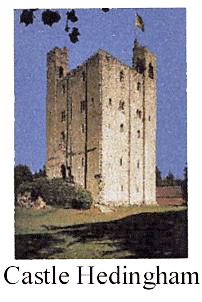 This Alberic was also justice of all England in that king's reign,
but about the 5th of king Stephen, was killed in a popular turmult
at London; leaving by Adeline his wife, daughter of Gilbert de
Clare, or, according to Collins, in his Extinct Peerage, daughter to
Roger de Ivery, three sons; viz. Alberic,
n.n canon of St. Osyth, in Essex;
Robert lord of Twiwell, in the county of Narthampton; Geffery, who,
the 12th Henry II, certified his knight's fee to be nine deveteri
seossamento and three de novo, and then resided in Shropshire; and
William; (constituted "chancellor of England", by Maud the empress),
and Juliana, Hugeot Bigot, earl of Northfolk. Alberic the third,
succeeded his father, and was so considerable a person, that Maud,
the empress, in order to engage him to her interest, confirmed to
him the office of great chamberlain, and all his father's estates,
with diver other inheritances, likewise the earldom of Cambridge, if
the earldoms of Oxford, Berkshire, Wiltshire, or Doreseshire. all
which grants, Maud's son, Henry II, confirmed, and constitutes him
Earl of Oxford, with the grant of the third penny of the pleas of
the county; a perquisite then belonging to the earls of this
kingdom. He died the 6th Richard I. having been twice married: This Alberic was also justice of all England in that king's reign,
but about the 5th of king Stephen, was killed in a popular turmult
at London; leaving by Adeline his wife, daughter of Gilbert de
Clare, or, according to Collins, in his Extinct Peerage, daughter to
Roger de Ivery, three sons; viz. Alberic,
n.n canon of St. Osyth, in Essex;
Robert lord of Twiwell, in the county of Narthampton; Geffery, who,
the 12th Henry II, certified his knight's fee to be nine deveteri
seossamento and three de novo, and then resided in Shropshire; and
William; (constituted "chancellor of England", by Maud the empress),
and Juliana, Hugeot Bigot, earl of Northfolk. Alberic the third,
succeeded his father, and was so considerable a person, that Maud,
the empress, in order to engage him to her interest, confirmed to
him the office of great chamberlain, and all his father's estates,
with diver other inheritances, likewise the earldom of Cambridge, if
the earldoms of Oxford, Berkshire, Wiltshire, or Doreseshire. all
which grants, Maud's son, Henry II, confirmed, and constitutes him
Earl of Oxford, with the grant of the third penny of the pleas of
the county; a perquisite then belonging to the earls of this
kingdom. He died the 6th Richard I. having been twice married:
-
First, to Eusamia, daughter of Sir William de Cantilupe, by whom he
had no issue;
-
secondly:
daughter (api ) to Lucia, daughter and heir of William de Abrincis
( by his wife, daughter and heir of William de Archis),
by whom he
had sons.
From 'The Itinerary' of the Reverend John Leland 1503 - 1552.
Dictionary of National Biography.
See Source Profile down below.
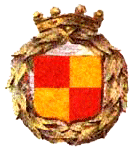
Aubrey (Alberic or Oberon) III de Vere
Had several issue including:
Robert de Vere
- scion of Odin - the Hooded God
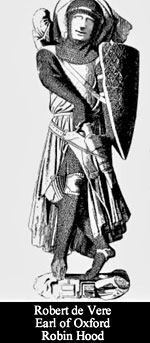 Robert de Vere. The historical claimant to the earldom of Cambridge
and Huntingdon, heritor of the lands of FitzOoth or Hood. Robert or
Robin - a Knight Templar in accordance with his legend - was
outlawed by King John and lost all his lands and castles. Robert was
the historical Robin Hood, Robin Goodfellow or Puck; see published
commentaries to Shakespeare's i.e. Edward de Vere's 'A Midsummer
Night's Dream' : Robin Hood or 'Puck's' father Oberon or Alberic
(de Vere) the Elf King descended - via Melusine - "from Morgan la
Fey and Julius Caesar". Such accords with Vere family genealogy.
Essentially a ritualised figure, Robin 'of the Hood' - the Green
Stag of the Wildwood - (a variation of the White Hart of Annwn,
Elphame or Faery) was an ancient, druidic form of the psychopomp or
guide of souls, in a similar manner as the Blue Boar. The ceremonial
office of the Robin Hood became - in late Dark Age and early
medieval times - that of God-King of the Witches and representative
of the Elven Host in decline, a Dragon Lord of the Grail. Robert's
descendant Edward de Vere, 17th Earl of Oxford, continued the role
of Robin Hood 'The Stag of the Wildwood' and King of the 'Calle
Daouine' in the reign of Good Queen Bess. Major Thomas Weir of Vere
- Grail Prince and Dragon Lord - also continued this role, that of
the Fairy God of the Witches, in the senior Scottish Branch of the
family descending to Nicholas de Vere. Robert de Vere. The historical claimant to the earldom of Cambridge
and Huntingdon, heritor of the lands of FitzOoth or Hood. Robert or
Robin - a Knight Templar in accordance with his legend - was
outlawed by King John and lost all his lands and castles. Robert was
the historical Robin Hood, Robin Goodfellow or Puck; see published
commentaries to Shakespeare's i.e. Edward de Vere's 'A Midsummer
Night's Dream' : Robin Hood or 'Puck's' father Oberon or Alberic
(de Vere) the Elf King descended - via Melusine - "from Morgan la
Fey and Julius Caesar". Such accords with Vere family genealogy.
Essentially a ritualised figure, Robin 'of the Hood' - the Green
Stag of the Wildwood - (a variation of the White Hart of Annwn,
Elphame or Faery) was an ancient, druidic form of the psychopomp or
guide of souls, in a similar manner as the Blue Boar. The ceremonial
office of the Robin Hood became - in late Dark Age and early
medieval times - that of God-King of the Witches and representative
of the Elven Host in decline, a Dragon Lord of the Grail. Robert's
descendant Edward de Vere, 17th Earl of Oxford, continued the role
of Robin Hood 'The Stag of the Wildwood' and King of the 'Calle
Daouine' in the reign of Good Queen Bess. Major Thomas Weir of Vere
- Grail Prince and Dragon Lord - also continued this role, that of
the Fairy God of the Witches, in the senior Scottish Branch of the
family descending to Nicholas de Vere.
      
Le Joli-Rougés du Templars
Aubrey's eldest surviving son:
Ralph de Vere, elder brother of Robin Hood.
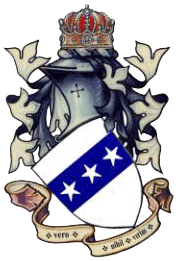
Ralph de Vere, founder of the Veres of Scotland
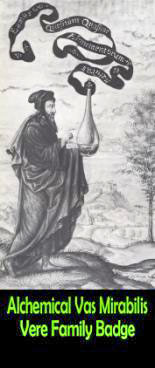 The first Aubrey de Vere on record (in Britain) came to England with
William the Conqueror. ................ He is usually held to be a
Norman, though he may have been a Breton; he certainly had strong
Connections with Brittany. Before the Conquest he was described as
one of the barons of Conan, Count of Brittany, and after the Battle
of Hastings he or his son (a second Aubrey) was allotted lands in
Essex by the overlord there, who was Alan of Brittany, now called
Alan, Count of Richmond in Yorkshire. The first Aubrey de Vere on record (in Britain) came to England with
William the Conqueror. ................ He is usually held to be a
Norman, though he may have been a Breton; he certainly had strong
Connections with Brittany. Before the Conquest he was described as
one of the barons of Conan, Count of Brittany, and after the Battle
of Hastings he or his son (a second Aubrey) was allotted lands in
Essex by the overlord there, who was Alan of Brittany, now called
Alan, Count of Richmond in Yorkshire.
Like all civil wars, the conflict between the Empress Maud and King
Stephen was a very troubling one.
It was really a fight between Normans and Flemings for the English
throne; and since Stephen's wife was the Flemish Matilda, Countess
of Boulogne, those Flemings already in England naturally flocked to
her side. For reasons best known to himself Aubrey III de Vere sided
with the Normans; he got his reward when the Empress Maud created
him Earl of Oxford.
It has been said, I think correctly, that before a man could be
given an earldom he had to have another honour.
Among those who supported Stephen and Matilda against the Normans
was Alan Earl of Richmond, and Aubrey III's second son, named Ralf,
went against his father and fought for Stephen in the army of his
own overlord.
The first officially recorded de Vere in Scotland was a Radulfus (or
Ralf) who was holding estates in Lanarkshire during the reign of
Alexander II. In 1160 Conan, Earl of Richmond, had married Margaret,
sister of the King of Scotland, and it seems likely that this may
have been the time when his follower, Ralf, was awarded his lands
there. We may note that when Aubrey III died, he was succeeded as
Earl of Oxford by his first son, Aubrey IV; but when that son died
childless the earldom passed to a third son, missing out the second
son, Ralf.
With thanks to Mrs Beryl Platts, author of 'The Scottish Hazard'.
Hereto and in published narratives it is made manifest that the most
senior bloodline of the entire Royal House of Vere in Great Britain
and Eire descends - not through the Oxford posterity - but through
the Scottish Branch extracted from Ralph de Vere, eldest son of
Aubrey III Earl of Oxford; and culminating contemporarily in the
elder progeny of the Veres of Kildress.

The senior Scottish descent of the Vere Earls of Oxford.
The Scottish name Weir is derived from the Norman-French de Vere.....
Alberic de Vere... accompanied the Conqueror.
Ralph or Radalphus de Ver was the first of the name on record in
Scotland. As Ralph de Ver he was taken prisoner at Ainwick in July
1174. As Radulphus de Weir, he witnessed a Charter of King William,
between 1174 and 1184. and as Radulph de Veir he gave a bovate of
land in Sprowston, Roxburgh, to Kelso Abbey. As Radalphus de Vere he
witnessed another Charter by King William to the Abbey of Lindores.
He also witnessed another undated Charter of King William's to
William de Hala, Herd (Errol.) The same, or perhaps a succeeding
Radulph de Ver, or de Uer witnessed about 1204 a grant to the Abbey
of Arbroath, and before 1214 another Charter by William the Lion.
The Weirs of Lanarkshire claimed to be descended from this Radulph.
...................Richard Wer, Lanark, rendered homage to Edward I
in 1296. Between 1398 and 1400 Rothald de Were, Baille of Lesmahagow,
had a Charter from Patrick, Abbot of Kelso, of the lands of
Blackwood, Mossiygning and. Durgundreston. and in 1497 Abbot Robert
granted Rogerhill and Brownhill to Robert Weyr for services
rendered..........................................
The English 'Weirs' (however) are descended from a progenitor who
dwelt at a weir or fishing dam.
One Scottish Weir crest is (was in 1700's) a demi-horse in armour
proper, bridled and saddled
gules. The motto is Nihil Verius.
Source:
From Dr. George Black.
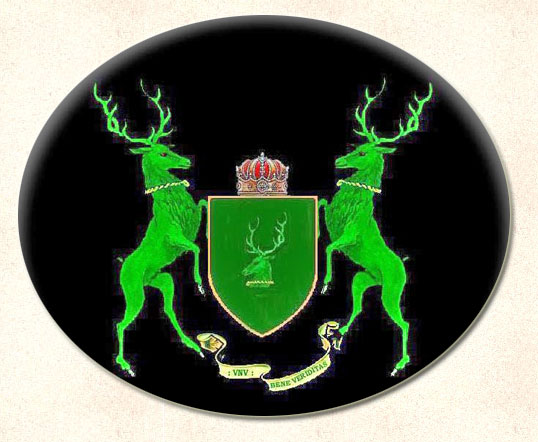
The descent of the senior Scottish Branch of Vere of Oxford
from
'The Surnames of Scotland', New York Public Library Edition.
Primary sources in italic.
WEIR............As Ralph de Vere he was taken prisoner at Alnwick
along with King William the Lion in 1174 (Bain, I, p. 174).He
witnessed a charter by King William 'de decimis episcopatus' of
Moray between 1174-84 (REM., 2), and as Radulph de Veir or Veyre,
within the same period, he gave a bovate of land in Sprowestun,
Roxburgh, to the Abbey of Kelso, his brother Robert being one of the
witnesses (Kelso, p. 177). The same or perhaps a succeeding Radulph
de Ver or de Uer witnessed a little before 1204 a grant to the Abbey
of Arbroath (RAA., I, 11) and before 1214 another charter by King
William (Panmure II, 126)
DE VERE and WEIR
Tartan: Weir (also Hope-Vere)
Motto: Vero Nihil Verius (Latin: Nothing Truer than Truth)
......Ralph de Ver, from whom the Weirs of Blackwood, Lanarkshire,
claim descent, was captured, with King William I (the Lion), in 1174
whilst besieging the castle of Alnwick in Northumberland. Others of
the name held land in Lesmahagow, Lanarkshire, in the fifteenth
century.
Major Thomas Weir (1599 - 1670) Consort of the Queen of Elphame; was
born at Kirkton House, Carluke. As an adult he lived at West Bow
(below left) and was burned at the stake in Edinburgh (below right)
for Witchcraft, Human Sacrifice (vampirism), Animal Sacrifice,
Congress with the "Queen of Hell", Incest with his step-daughter
Elizabeth Bourdon and also with his sister. His sister was hanged
the next day for her part in some of his activities.
'Scotland and her Tartans' Alexander Fulton.
(Major Thomas Weir was the grandson of William Vere of Stonebyres
and Lady Elizabeth Hamilton. His father Thomas married the witch,
Lady Jane Somerville. Major Weir was the ancestor of the Tyrone
Kildress Branch).
'Of The Fesse' Chapter X. From the Archives of:
The Lyon King of Arms of Scotland.

The Scottish Clan and Family Encyclopedia
(The Armigerous Clans and Families of Scotland)'
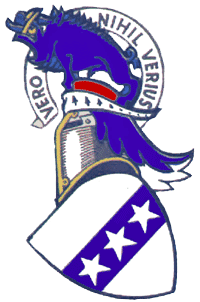
Hope Vere and Weir
Arms (of Blackwood LR 4/94)1
Argent, on a fess Azure, three mollets of the first
(Of The Royal Scythian, Pictish Clan Of Mar)
Crest
(As Oxford)
Upon a chapeau Gules furred Ermine
a boar standant Azure armed Or.
Motto
(As Oxford)
'Vero Nihil Verius'
(Nothing Truer than Truth)
1. Lyon Roll of Arms.
Court of the Lyon King of Arms, Edinburgh.
Ralph de Ver was captured along with William the Lion at Alnwick in
Northumberland in 1174. He witnessed a charter of his king of lands
in the bishopric of Moray sometime between 1174 and 1184. He also
donated land to the Abbey of Kelso, and his brother Robert was a
witness. The Weirs of Blackwood in Lanarkshire, who (through a
female descent) were to become the principal family, claim descent
from Ralph de Vere.
(The claim is upheld in the Lyon Rolls as evidenced above).
Senior descent of the Veres of Oxford in Scotland and Eire
continued.
Ralfredus ('Baltredus'/Ralph) de Vere
- the eldest surviving son and rightful heir of Aubrey III de Vere
Earl of Oxford opposed his father in the Flemish war, was
disinherited and fled to Scotland with his Liege Lord Conan of
Brittany in approx 1165. Conan married the sister of the king and
Ralph was given his lands in Lanark. He was a witness to a charter
of King William, The Lion of Scotland 1165 - 1214. Ralph and William
were captured after beseiging the Castle of Alnwick in Northumbria
in 1174.
Had a son:
Walter Rory de Vere
Who had a son:
Ralph (Rudolphus) de Vere
Confirmed his father's donation to Kelso Monastery. Died at the end
of the reign of
Alexander II of Scotland 1214 - 1249
Had a son:
Thomas de Vere
Living in 1266. Witness to a charter of a donation to Kelso
Monastery by Hemicus St Clan.
Had a son:
Richardus de Vere (de Were)
Living approx 1294. Laird (Lord or Baron) of Blackwood. Lanarkshire.
Mentioned in a donation to Kelso Monastery
Had a son:
Thomas de Were (de Vere) of Blackwood
Proprietor of the lands and Barony of Blackwood, Lanarkshire. Died
in the reign of David the Bruce; David II of Scotland 1329 - 1371
Had a son:
Brian (Buan) Were of Blackwood
Living around 1386, Brian's 6th cousin, Robert De Vere IXth earl of
Oxford, Lord of Hedingham, was Marquess of Dublin and Duke and Vice
Regent of Ireland. Robert was effectively the Sovereign Prince of
Ireland during his lifetime and was permitted by King Richard II to
mint coins with his own likeness. Although attainted during his
lifetime, after his death King Richard restored Robert's titles in
full in memorium and these are now held de jure by the Irish Branch.
Brian died in the beginning of the reign of King Robert III of
Scotland 1390-1406.
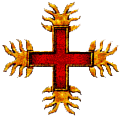
Whilst the House of Vere bore heraldically the 'Double Dragon
Device' of the Dragon Court of Melusine long before this period - id
est circa 1200 a.d. - it is believed academically that it was 200
years afterwards, during the investiture together of Emperor
Sigismund and Richard de Vere XIth earl of Oxford into the 'princely
degree' of the Knights of the Garter at St. George's Chapel, Windsor
by King Henry IV, that Richard de Vere also received his investiture
into the Societas Draconis by Emperor Sigismund. On the evidence of
historical precedent, such an investiture; and the Dragon Name,
became heritable. In this regard and by a process of lateral
inheritance the Vere Dragon Court includes the degree of 'Sarkany
Rend': Societas Draconis.
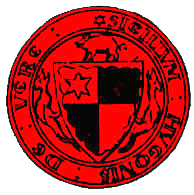
Ancient Alchemical Double
Dragon Seal of Vere
In Heraldry the Supporters of a shield or escutcheon, to give it its
proper name, are derived from the ofttimes preheraldic family badges
or totems of the father and mother's Royal and Noble antecedents.
The father's supporter is to the right or dexter of the shield -as
it would be held by the combatant- and the mother's supporter is to
the left or sinister of the escutcheon. As we can see from the seal
above, the Veres are of dragon blood in both the patrilinear and
matrilinear descents and are consequently of pure Elven lineage. The
Boar crest surmounting the shield is the the Blue Boar or La
Solitaire, which in ancient Gaelic is the symbol of the Arch-Druid.
Brian had a son:
Rotaldus Were of Blackwood
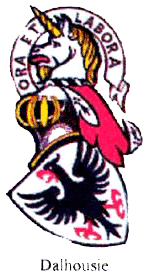 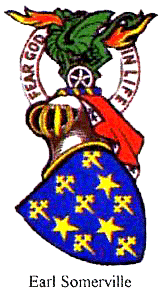 Received a charter from Patrick, Abbot of Kelso Monastery; dated
1404. He was Baillie of Lesmahagow from 1398 - 1400. Died in the
reign of King James II of Scotland 1437 -1460 Received a charter from Patrick, Abbot of Kelso Monastery; dated
1404. He was Baillie of Lesmahagow from 1398 - 1400. Died in the
reign of King James II of Scotland 1437 -1460
Had a son:
Thomas Were (de Vere) of Blackwood
Had a son:
Robert Veyr of Blackwood
Died soon after receiving a charter of confirmation from Robert, the
Abbot of the Monastery of Kelso dated 1474.
Had a son:
Thomas Weir of Vere of Blackwood
Married Lady Aegidia, daughter of John, 3rd Lord Somerville (of the
Dragon) in 1483. Aquired vast holdings of land and was patron of St.
Mary's Church in Lesmahagow. Died in the beginning of the reign of
Queen Mary of Scots in 1542.
Plantagenet descent of the House of Vere
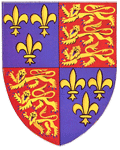  
Thomas had a son:
James Weir of Vere, 7th Baron Blackwood
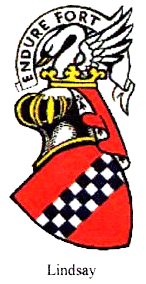 Married Lady Euphemia Hamilton, (Merovingian descent) sister of the
Duke of Chatelherault, Marquess of Hamilton, 5th Grandson of King
Edward III Plantagenet. The Hamiltons were the Heirs Presumptive to
the Throne of Scotland during this period. James lived to a great
age. He died in 1595. Had sons: Married Lady Euphemia Hamilton, (Merovingian descent) sister of the
Duke of Chatelherault, Marquess of Hamilton, 5th Grandson of King
Edward III Plantagenet. The Hamiltons were the Heirs Presumptive to
the Throne of Scotland during this period. James lived to a great
age. He died in 1595. Had sons:
1. James Weir
2. William Vere of Stonebyres who married Elizabeth Hamilton.
3. Robert Weir
James married Lady Marriotte Ramsay, daughter of George, Lord
Dalhousie. James was an ancestor of the Hope-Veres of Craig Hall.
George Ramsay was created Earl of Melrose in 1618 and changed this
to the earldom of Dalhousie in 1619. The 9th earl was Governor of
Canada, Nova Scotia and New Brunswick. His son was Governor General
of India.

1. James had issue:
George Weir of Vere who married Margaret Vere of Stonebyres with
whom he had one daughter:
Marriotte Weir who married:
1st. = Major James Bannatyne (a sept of the Stewarts of Bute).
2nd. = William Lowry by whom she had a Son George who retained his
mother's superior Vere name and became
Sir George Weir Bt. (descent to Hope-Vere of Blackwood). The Hope-Veres
died out in 1974.
In the beginning of the 18th century Catherine Weir - daughter of
Sir George Weir Bt. - married Charles Hope and changed the spelling
of the name Weir back to Vere, not wishing to be continually known
by a series of historical spelling mistakes and variations. The Lord
Lyon King of Arms of Scotland acknowledges and records the
restoration of the name Vere from its incorrect rendition as 'Weir'.
Today the senior families use the affectation 'Weir of Vere' or
simply 'de Vere' as the name is correctly accepted and most often
historically rendered. (See Burke's extraction below).
It is also to be noted that - as recorded in historical
dissertations, documents and Wills pertaining thereunto - the Weirs
or Veres made it a clause in their inheritance practice that any man
marrying a Vere heiress had to change his name in order to enjoy the
benefits of his intended spouse's wealth and lands. Furthermore the
name Vere was considered to hold seniority and superiority over all
other names in Britain and in the case of a female becoming sole
heiress, it was not considered fitting that she should take to
herself solely her husbands surname, as was usually the practice. In
this family - when the occasion arises - the female surname of Vere
is either taken by the husband and father to be or occupies the
latter position traditionally taken by a husband's surname in other
families.
2. William Vere of
Stonebyres.
See 'Vere of Tyrone' below.
(Merovingian descent).

3. Robert Weir of Vere of Craighead,
sold or assigned his estate in
1610 and moved to Monaghan Hall in Co.Fermanagh, now renamed
Hallcraig House. Robert married the sister of the alchemist Sir
David Lindsay, The Lord Lyon King of Arms of Scotland.


Robert had sons, the eldest surviving son was:
Alexander who married Anne, Daughter of Sir John Dunbar (Graham
descent) of Derrygonnelly, Co. Fermanagh. Their eldest son:
Alexander married Sarah, daughter of Captain Goodwin and secondly,
Elizabeth, daughter of Sir Paul Gore Bt. Their eldest son: Robert
Weir of Hallcraig married Anne, daughter of Captain Carleton of
Tullymargy Castle. They had a son Captain Alexander Weir of
Hallcraig (from whom the Normanised branch of the House of Vere
descends to Nicholas de Vere's ducal kinsman – Prince An Mhaior - by
Papal Decree HI&RH The Archduke of Argentina) and Captain Noble Weir
of Hallcraig who married Catharine Graham (descent from the Grahams
of Scotland 1600) and had issue.
From Robert various branches descend.
('Burke's Irish Landed Gentry' 1891-1915; 'Burke's Landed gentry'
1974; 'Burke's Peerage, Baronetage and Knightage' 1957; Burke's
Dormant and Extinct Peerages).


  From the senior surviving son - William Vere of Stonebyres by
Elizabeth Hamilton - a son Thomas of Kirkton who by the Witch - Lady
Jane Somerville - had Major Thomas Weir of Edinburgh: Sorcerer, King
of the Witches of the Lallan and Elven Prince Consort to the Queen
of Faery or Elphame - or as some say - "The Queen of Hell". The
Somerville Badge was the Fiery Dragon surmounting the Pentacle.
Major Weir served with his Irish cousins as a Captain Lieutenant in
Sir John Hume's Enniskillen regiment in Ulster in 1640 and by family
tradition he founded the Tyrone Branch of the family. From the senior surviving son - William Vere of Stonebyres by
Elizabeth Hamilton - a son Thomas of Kirkton who by the Witch - Lady
Jane Somerville - had Major Thomas Weir of Edinburgh: Sorcerer, King
of the Witches of the Lallan and Elven Prince Consort to the Queen
of Faery or Elphame - or as some say - "The Queen of Hell". The
Somerville Badge was the Fiery Dragon surmounting the Pentacle.
Major Weir served with his Irish cousins as a Captain Lieutenant in
Sir John Hume's Enniskillen regiment in Ulster in 1640 and by family
tradition he founded the Tyrone Branch of the family.
From Major
Weir - who was burnt at the stake at Leith, Edinburgh in 1670 - a
son Thomas whose issue decamped to Ireland during the witch craze,
from whom John of Kildress whose son Andrew had a daughter -
Margaret Weir of Vere of Kildress - who by Archibald Thompson had a
son Archibald Weir of Vere. Archibald married Rachael Stewart and
had issue. The eldest son Robert Weir of Vere married a Vere cousin
- Sarah Graham - and had a son John who moved back to Scotland and
married Mary Logan of Logan Manor in Galloway. The Logan families
have held their lands in Galloway and the Stranraer Peninsula since
the 1100's, whilst others of that name held Restalrig. Accompanying
Sir James Douglas, two Logan Knights, Sir Walter and Sir Robert
Logan, were killed in Spain whilst taking the heart of Robert the
Bruce to the Holy Land for burial.
John's eldest son:
 Thomas Weir of Vere of Lewes married a Gael, Anne Grant Macdonnell
of Inverness. They had male issue, the eldest of which died without
heirs. The second eldest and surviving son: James Weir of Vere of
Lewes who married a Vere-Collison family cousin Natalie Hopgood,
daughter of George Collison Hopgood Esquire and Julia Harding of
Godalming, grand daughter of Captain George Butcher of the 11th
Light Dragoons (Lieutenant Colonel of the Regiment in the field), of
Windsor Castle and Osbourne House; Tapetiere to Queen Victoria.
Family Colleges: Charterhouse, Godalming, Surrey UK., and St.
Ursula's College. Thomas Weir of Vere of Lewes married a Gael, Anne Grant Macdonnell
of Inverness. They had male issue, the eldest of which died without
heirs. The second eldest and surviving son: James Weir of Vere of
Lewes who married a Vere-Collison family cousin Natalie Hopgood,
daughter of George Collison Hopgood Esquire and Julia Harding of
Godalming, grand daughter of Captain George Butcher of the 11th
Light Dragoons (Lieutenant Colonel of the Regiment in the field), of
Windsor Castle and Osbourne House; Tapetiere to Queen Victoria.
Family Colleges: Charterhouse, Godalming, Surrey UK., and St.
Ursula's College.
 James and Natalie had an only son: James and Natalie had an only son:
Prince Nicholas Thomas Logan Weir of Vere (Nicholas de Vere)
Gm.K.T., K.C.D., Knight Templar; Knight of Clan Donnachaid
of Eire; Magister Templi via the Baphometic Order of The Cubic
Stone 1118; Princeps Draconis. By Gaelic blood descent and de
jure Clan Chief and Head of The Royal House of Vere in England.
Parish Records for
Ulster 1820 - 1845, United Kingdom Government Registers for
Births, Marriages and Deaths 1845-1957. Sussex Register of Electors
U.K. Sussex Courts of Law U.K. British Government Department of
Internal Affairs. Burke's Genealogies.

Genetics
The relationship between
the Prince Mhaior - The Archduke of Argentina - who, by Normanised
descent, is the Head of the Irish House of Vere and Nicholas de Vere;
who - by Gaelic blood descent - is also Chief of the Tyrone Kildress
Branch is that of 4th and 14th cousins. Both share various identical
genes. Found in only 3% and 6% of the clinical samples tested in
Britain, Nicholas de Vere and the Head of the House in Eire share
two sets of rare genes each. The Prince Mhaior is of Royal Collison
extraction and Nicholas de Vere has an extra set of these genes from
the matrilinear descent which also supports the Royal Collison
descent from Norfolk in his own lineage and echoes the selective and
exclusive royal and noble marital alliances which have continued
throughout the history of the House of Vere.
The House of Weir and Vere commissioned genetic tests to be
undertaken to confirm the precise degree of relationship between
their respective lines and in order to clarify any anomolies in
genealogy that inevitably creep into the records as the mists of
time occlude the past. This was acheived successfully and some
records were amended to reflect genetic findings both in Nicholas'
lineage and that of another of his Vere cousins in Ireland,
confirming that Nicholas' descent is one of the senior bloodlines of
the House of Vere.
However, the genetic makeup of the House of Vere manifesting
generation after generation proved to be so unusual that, beyond the
remit of the original commission by the family, the Department of
Haemogenetics at London University took the Veres on as a special
study case. At this particular stage of the research a Conference
Presentation Document has been submitted prior to the delivery of a
Medical Paper at a forthcoming Genetics Symposium in the United
States, by an eminent professor in the department who is an
internationally recognised pioneer in genetics. Further racial and
mitochondrial studies on the Vere family are planned by the
department.

Notes
The Royal House of Vere
- The Senior Angevin House of the original 'Princes and Counts of
Anjou' - are latterly of Breton and Flemish extraction and the
former senior, Scottish Branch; Hope-Vere of Blackwood,
traditionally observed the Flemish law of Noblesse Uterine, and
matrilinear and family inheritance in accordance with noble Scottish
family law, which contemporarily and historically supports blood
descent.
The Titles of Princeps Draconis and Prince de Vere, currently held
by Nicholas de Vere, are acknowledged as foreign titles in
confidential files held by the British Government's Department of
Internal Affairs: 'The Home Office' and are registered with them as
'Official Observations'. These titles are recognised by the most
senior branches of the House of Vere. The right of fons honorum held
by Nicholas de Vere is also acknowledged by Her Majesty's
government.
Nicholas de Vere, though accepting the existence of both with some
considerable qualification; does not claim to be either a member of
the contemporary British royal household or of its peerage in any
sense, and does not claim any status or rank suggestive of such or
appertaining thereunto. The Vere princedoms are not modern, socially
derived titles; either assumed or bestowed, for or by, political
expediency.
The princedoms of Vere are ancient cultural manifestations of
genetic qualities carried in the historical Elven Blood Royal.
Established in Angiers in 740 a.d. as a Royal House arising from far
older sacral-regal, Pictish, Scythian Vere origins rooted in
antiquity, the House of Vere is recorded in a single name and in an
unbroken line for over one thousand three hundred years, and
consequently is one of the oldest surviving royal dynasties in
Europe.

Genealogical
Source Profiles
'Histories of
England'
- Baron Thomas
Babington Macaulay, Lord Macaulay of Rothley Temple, (1800 -
1859). Politician and historian. Educated at Trinity College,
Cambridge he became one of the acknowledged intellectual pundits
of his age. He entered the Supreme Council for India in 1834
where his famous 'Minutes on Law and Education' had a decisive
influence on the development of the sub-continent. He was
Secretary-At-War 1839-41 and went on to write his acclaimed,
best-selling 'Histories of England' between 1849-1855. "He used
a wide range of manuscript sources with great skill, and modern
historians neglect his reconstruction of events at their peril",
Margaret Drabble CBE, Morley College.
'The Dictionary of National Biography'
- designed and
published by George Smith (1824-1901) The Dictionary was first
published in 1882 with Sir Leslie Stephen (1832-1904) as editor.
The DNB in its original form included biographies of all the
national notabilities from the earliest time to 1900. The work
has been continued by the publishing of decennial supplements.
Stephen was succeeded as editor by Sir Sydney Lee and their
names appear jointly on the title pages of volumes XXII to XXVI
(1890). In 1917 the Dictionary was transferred to Oxford
University.
'Myths of the Middle Ages'
- Reverend Father
Sabine Baring Gould, Lord of Lew Trenchard, Devon, (1834-1924).
Baring-Gould travelled the Continent extensively and was
educated at Clare College, Cambridge. An Antiquarian and
folklorist, Baring-Gould; a prolific writer, was the author of
numerous works including 'Mehalah', which Swinburne compared to
'Wuthering Heights'.
'Burke's Peerage'
- properly 'A
Genealogical and Heraldic history of the Peerage and Baronetage
of the United Kingdom' 1826 -1947, first compiled by John Burke
in 1826 and published anually after 1947.
'The Itinerary'
- Reverend John
Leland, (1503-1552). "The earliest of modern antiquaries" Leland
was educated at St. Paul's School and Christ's College,
Cambridge. He studied in Paris, took holy orders and by 1530 was
involved with the Royal Libraries. From 1533 he received a
commission from King Henry VIII to search the monastic and
collegiate libraries for old authors. He made a tour through
England between 1535 and 1543 intending his researches to be the
basis of an opus magna on the 'Histories and Antiquities of the
Nation'. His notes were first published at Oxford University by
the historian Thomas Hearne (1678-1735) as 'The Itinerary' in
nine volumes in 1710-12. Lucy Toulmin Smith produced an edition
of 'The Itinerary' in 1906-10 in which she noted that the
descent of Vere was included as an extract from Folio 42 of the
original work which was formerly preserved in Stow's original
collection.
'Stow MSS'
- John Stow
(1525-1605). A collection of manuscripts first collated in 1564.
Stow transcribed manuscripts and was the first person to compose
historical works based on a systematic study of Public Records.
He assisted Parker with editing historical texts and his chief
publications were 'The workes of Geoffrey Chaucer' (1561);
'Summary of English Chronicles' (1565); 'The Chronicles of
England' (1580) and a 'Survey of London'. An edition of the
collection was published by Strype in 1720 and the fullest
edition of the original work was C.L. Kingsford's, which was
published in 1908.
'Complete peerage of England, Scotland, Ireland, Great
Britain and the United Kingdom, extant, extinct or dormant'
- George Edward
Cokayne MA, born in Russell Square, London in 1825; the son of
Dr. William Adams LLD and The Hon. Mary Anne Cokayne, neice and
co-heiress of Borlase, 6th Viscount Cullen. Complying with his
mother's wishes Cokayne changed his name by royal license on
15th August 1873. Cokayne was educated at Exeter College,
Oxford. Barrister; Lincoln's Inn (1853); Rouge Dragon Pursuivant-of-Arms
(1859-1870), Lancaster Herald (1870-1882); Norroy King-of-Arms
(1882-1894) Clarenceux King of Arms from 1894. His 'Complete
Peerage of the United Kingdom...' in 8 volumes was compiled
between 1887-98 and published by George Bell. Holding Library:
Trinity College Dublin.
'Royal Genealogies' or 'The genealogical tables of emperors,
kings and princes from Adam to these times' by Dr. James
Anderson DD., MA., (1680-1739).
- Anderson was born
in Aberdeen where he was also later educated and took his
degrees. He was appointed Presbyterian Minister for Swallow
Street and Lisle Street, Leicester Fields in London between 1710
and 1734. Described as "a learned man" Anderson; who was a
Freemason, was assigned the task, in 1721, of compiling an
authoritative digest of the 'Constitutions' of the fraternity
(see: Entick's edition of 1747; page 194 et seq). As Grand
Warden of the Grand Lodge in London he presented his work to the
Order in 1723. It has appeared in numerous subequent editions
and has been long recognised by English Freemasons as the
standard code on its subject. Editions were translated into
German and also appeared in America in 1855, as facsimiles of
the earlier English Version. The work by which Anderson is
chiefly remembered; 'The Royal Genealogies', was first published
in 2 volumes in London in 1732. Anderson based this work on the
earlier 'Genealogische Tabellen' of Johann Hubner. See below.
The relatively later tables of the 'Genealogies' were considered
by Sir Stephen Leslie (Dictionary of National Biography) "to be
of use (i.e. a valid historical source work) in relation to the
genealogies of continental dynasties and houses", (Re: Vere).
'Royal Genealogies': Holding Library; Cambridge University.
Genealogische Tabellen' -
Johann Hubner.
Properly: 'Der Genealogische Tabellen zur erlauterung der
politische historie vom anfange biss auf diesen tag continuiret',
published in one volume, Leipzig 1719. Holding library: Glasgow.
'The Collections' -
Sir James Dalrymple.
'Collections concerning the Scottish history, preceeding the
death of King David the First, in the year 1153. Wherein the
soveraignity of the crown and independency of the church are
cleared; and account given of the antiquity and purity of the
Scottish-British church, and the novelty of popery in this
kingdom. With an appendix containing the copies of charters of
foundation of some churches; with genealogical accounts of the
donors and witnesses'. First Published in Edinburgh in 1705 by
the heirs and successors of Andrew Anderson sold by John
Vallange and Mrs. Ogstoun ...[8], LXXXVI, [4], 432, [4] p. (8o)
Holding Library: Durham
'The surnames of Scotland, their origin, meaning, and
history'
- by Dr. George
Fraser Black. Published in New York in 1946 : The New York
Public Library. Holding Libraries: Cambridge ; Edinburgh ; Leeds
; Liverpool ; Nottingham ; SAS ; Sheffield

Primary Sources for
Vere Genealogies on site
Family Archives of the
House of Vere of Oxford, Lanark, Fermanagh and Clare.
Bain I, 174.
Panmure II, 126.
Colne Priory MSS.
Kelso Abbey MSS.
Paisley Abbey MSS.
Arbroath Abbey MSS.
Charter 'De Decimus Episcopatus', Moray.
'The Plantagenet Chronicles' Thomas de Loche (1130) and Jean
de Mortimer (1164-1173).
Transcript of the trial of Major Thomas Weir, Edinburgh,
April 11th 1670. House of Vere.
Sir Randolph Crew's summary - House of Lords Archives.
Roll of Arms of the Lord Lyon King of Arms of Scotland (a
Government Office), Lyon Court, Edinburgh, Scotland.
Arden, St. George and Glover Rolls of Arms, ref: College of
Arms (a Government Office), London, England.
Parish Records and Census Returns for County Tyrone - Public
Records Office, Belfast, Northern Ireland.
Griffith's Valuations for Tyrone - Public Records Office,
Belfast.
Parish Tithe Records for County Tyrone - P.R.O. Belfast.
Parish Records and Census Returns for Wigtonshire - Scottish
Records Office, New Register House, Edinburgh, Scotland.
Registry for Births, Marriages and Deaths for Cumbria, Kent,
East Sussex, Hertfordshire and West Sussex - St. Catharine's
House Records, Preston, Lancashire, England.
Department of Genetics and Haematology, London University,
U.K.
Home Office, London, England.

Verification of Title
and Identity

Pre 1997 passport title page

Post 1997 passport title page

The 'von Drakenberg' title printed on back page

The Imperial and Royal Dragon Court
This copy was revised on May 27th 2002 to reflect
the latest genetic and archival discoveries.
|


 Introduction
Introduction


 The Falling Star of Vere
The Falling Star of Vere 






 A count of Anjou came back with a new wife, a strange girl of
extraordinary beauty but she kept very much to herself. Unusually in
so religious an age she was reluctant to attend the Mass. When she
did go she always hurried from the church before the consecration of
the host. Her husband, who was puzzled by her behaviour, told four
knights to keep watch and to try to delay her departure from the
church. When she got up to go, one of them trod on the hem of her
train. As the priest raised the host to consecrate it she screamed,
wrenched herself free, and still shrieking, flew out of the window,
taking two of her children with her. In reality the countess was the
wicked fairy, Melusine, the daughter of Satan, who cannot abide the
consecration of the body of Christ in the Mass. It was from the
children that she left behind that the counts of Anjou and the
Angevin kings of England were said to be descended.
A count of Anjou came back with a new wife, a strange girl of
extraordinary beauty but she kept very much to herself. Unusually in
so religious an age she was reluctant to attend the Mass. When she
did go she always hurried from the church before the consecration of
the host. Her husband, who was puzzled by her behaviour, told four
knights to keep watch and to try to delay her departure from the
church. When she got up to go, one of them trod on the hem of her
train. As the priest raised the host to consecrate it she screamed,
wrenched herself free, and still shrieking, flew out of the window,
taking two of her children with her. In reality the countess was the
wicked fairy, Melusine, the daughter of Satan, who cannot abide the
consecration of the body of Christ in the Mass. It was from the
children that she left behind that the counts of Anjou and the
Angevin kings of England were said to be descended.
 Vere Princedom
Vere Princedom  But while the king was supreme authority in the realm, he was not
obliged - or even expected - to sully his hands with the mundane
business of governing. He was essentially a ritualised figure, a
priest-king, and his role was not necessarily to do anything, simply
to be. The king ruled in short, but did not govern.
But while the king was supreme authority in the realm, he was not
obliged - or even expected - to sully his hands with the mundane
business of governing. He was essentially a ritualised figure, a
priest-king, and his role was not necessarily to do anything, simply
to be. The king ruled in short, but did not govern.


 In the matter of the succession of Robert de Vere to the earldom of
Oxford in the
In the matter of the succession of Robert de Vere to the earldom of
Oxford in the
 reign of Charles I, the title was contested for by
Lord Willoughby de Eresby. Several Judges of the day were appointed
to guide the Lords in legal matters regarding this succession.
Leading them was the Lord Chief Justice of England, Sir Randolph
Crew. Robert de Vere won the case and the Crown vouchsafed the
earldom of Oxford to him. The summing up speech delivered by the
Lord Chief Justice before the House of Peers (The House of Lords)
was recorded as part of the judicial process (Sir Bernard Burke) and
its comments are therefore part of English Law.
reign of Charles I, the title was contested for by
Lord Willoughby de Eresby. Several Judges of the day were appointed
to guide the Lords in legal matters regarding this succession.
Leading them was the Lord Chief Justice of England, Sir Randolph
Crew. Robert de Vere won the case and the Crown vouchsafed the
earldom of Oxford to him. The summing up speech delivered by the
Lord Chief Justice before the House of Peers (The House of Lords)
was recorded as part of the judicial process (Sir Bernard Burke) and
its comments are therefore part of English Law.  1000+ Albery II de Vere: Earl of Genney wed - Beatrice Sister to
King William the Conqueror: Vere descent from the Merovingian
dynasty. Alberic went with the King to England. He used the
motto,"Albri Comes" which some say is "Albery of truth cometh", de
-of ; Ver- true. But Comes simply means Count. Albery is also Aubri,
Albury, Alberic (in Latin); Alphonsus (in Greek). He built "Hedingham
Castle". At the time of the general survey, Alberic de Ver was
already noted as a person of ancient and noble descent (Domesday
Book). Leland, stated or deduced that the pedigree of this family
was from "Noah", Meleager, who slew the Caledonian boar, and
Diomedes, who was at the seige of Troy.- N.B. Caesar and
Charlemagne.
1000+ Albery II de Vere: Earl of Genney wed - Beatrice Sister to
King William the Conqueror: Vere descent from the Merovingian
dynasty. Alberic went with the King to England. He used the
motto,"Albri Comes" which some say is "Albery of truth cometh", de
-of ; Ver- true. But Comes simply means Count. Albery is also Aubri,
Albury, Alberic (in Latin); Alphonsus (in Greek). He built "Hedingham
Castle". At the time of the general survey, Alberic de Ver was
already noted as a person of ancient and noble descent (Domesday
Book). Leland, stated or deduced that the pedigree of this family
was from "Noah", Meleager, who slew the Caledonian boar, and
Diomedes, who was at the seige of Troy.- N.B. Caesar and
Charlemagne.
 "H Rex Anglrorum, &c. Sciatis universi quoniam dedi & concssi
Alberico de Ver & hereib, ' suis post eum de me & meis tenend'
magistram camerarim ,eamtotius Anglie in feode & hereditate quare
volo & firmiter precipio quod ipse & heredes sui eam jure
hereditario teneant cim omnibus dignaitatibus & libertatib'&
honorisicentitis ad eam pertinentibus, ita bene &libere & honorisice
sicat Robertus Malet vel aliquis alius ante vel pst cum inquam
melius & nonorisicntius tenuit, cum liberartionibus & hospiciis
curie mee que ad ministerium cameratieae pertinent" Test. &c.
"H Rex Anglrorum, &c. Sciatis universi quoniam dedi & concssi
Alberico de Ver & hereib, ' suis post eum de me & meis tenend'
magistram camerarim ,eamtotius Anglie in feode & hereditate quare
volo & firmiter precipio quod ipse & heredes sui eam jure
hereditario teneant cim omnibus dignaitatibus & libertatib'&
honorisicentitis ad eam pertinentibus, ita bene &libere & honorisice
sicat Robertus Malet vel aliquis alius ante vel pst cum inquam
melius & nonorisicntius tenuit, cum liberartionibus & hospiciis
curie mee que ad ministerium cameratieae pertinent" Test. &c. This Alberic was also justice of all England in that king's reign,
but about the 5th of king Stephen, was killed in a popular turmult
at London; leaving by Adeline his wife, daughter of Gilbert de
Clare, or, according to Collins, in his Extinct Peerage, daughter to
Roger de Ivery, three sons; viz. Alberic,
n.n canon of St. Osyth, in Essex;
Robert lord of Twiwell, in the county of Narthampton; Geffery, who,
the 12th Henry II, certified his knight's fee to be nine deveteri
seossamento and three de novo, and then resided in Shropshire; and
William; (constituted "chancellor of England", by Maud the empress),
and Juliana, Hugeot Bigot, earl of Northfolk. Alberic the third,
succeeded his father, and was so considerable a person, that Maud,
the empress, in order to engage him to her interest, confirmed to
him the office of great chamberlain, and all his father's estates,
with diver other inheritances, likewise the earldom of Cambridge, if
the earldoms of Oxford, Berkshire, Wiltshire, or Doreseshire. all
which grants, Maud's son, Henry II, confirmed, and constitutes him
Earl of Oxford, with the grant of the third penny of the pleas of
the county; a perquisite then belonging to the earls of this
kingdom. He died the 6th Richard I. having been twice married:
This Alberic was also justice of all England in that king's reign,
but about the 5th of king Stephen, was killed in a popular turmult
at London; leaving by Adeline his wife, daughter of Gilbert de
Clare, or, according to Collins, in his Extinct Peerage, daughter to
Roger de Ivery, three sons; viz. Alberic,
n.n canon of St. Osyth, in Essex;
Robert lord of Twiwell, in the county of Narthampton; Geffery, who,
the 12th Henry II, certified his knight's fee to be nine deveteri
seossamento and three de novo, and then resided in Shropshire; and
William; (constituted "chancellor of England", by Maud the empress),
and Juliana, Hugeot Bigot, earl of Northfolk. Alberic the third,
succeeded his father, and was so considerable a person, that Maud,
the empress, in order to engage him to her interest, confirmed to
him the office of great chamberlain, and all his father's estates,
with diver other inheritances, likewise the earldom of Cambridge, if
the earldoms of Oxford, Berkshire, Wiltshire, or Doreseshire. all
which grants, Maud's son, Henry II, confirmed, and constitutes him
Earl of Oxford, with the grant of the third penny of the pleas of
the county; a perquisite then belonging to the earls of this
kingdom. He died the 6th Richard I. having been twice married:



 Robert de Vere. The historical claimant to the earldom of Cambridge
and Huntingdon, heritor of the lands of FitzOoth or Hood. Robert or
Robin - a Knight Templar in accordance with his legend - was
outlawed by King John and lost all his lands and castles. Robert was
the historical Robin Hood, Robin Goodfellow or Puck; see published
commentaries to Shakespeare's i.e. Edward de Vere's 'A Midsummer
Night's Dream' : Robin Hood or 'Puck's' father Oberon or Alberic
(de Vere) the Elf King descended - via Melusine - "from Morgan la
Fey and Julius Caesar". Such accords with Vere family genealogy.
Essentially a ritualised figure, Robin 'of the Hood' - the Green
Stag of the Wildwood - (a variation of the White Hart of Annwn,
Elphame or Faery) was an ancient, druidic form of the psychopomp or
guide of souls, in a similar manner as the Blue Boar. The ceremonial
office of the Robin Hood became - in late Dark Age and early
medieval times - that of God-King of the Witches and representative
of the Elven Host in decline, a Dragon Lord of the Grail. Robert's
descendant Edward de Vere, 17th Earl of Oxford, continued the role
of Robin Hood 'The Stag of the Wildwood' and King of the 'Calle
Daouine' in the reign of Good Queen Bess. Major Thomas Weir of Vere
- Grail Prince and Dragon Lord - also continued this role, that of
the Fairy God of the Witches, in the senior Scottish Branch of the
family descending to Nicholas de Vere.
Robert de Vere. The historical claimant to the earldom of Cambridge
and Huntingdon, heritor of the lands of FitzOoth or Hood. Robert or
Robin - a Knight Templar in accordance with his legend - was
outlawed by King John and lost all his lands and castles. Robert was
the historical Robin Hood, Robin Goodfellow or Puck; see published
commentaries to Shakespeare's i.e. Edward de Vere's 'A Midsummer
Night's Dream' : Robin Hood or 'Puck's' father Oberon or Alberic
(de Vere) the Elf King descended - via Melusine - "from Morgan la
Fey and Julius Caesar". Such accords with Vere family genealogy.
Essentially a ritualised figure, Robin 'of the Hood' - the Green
Stag of the Wildwood - (a variation of the White Hart of Annwn,
Elphame or Faery) was an ancient, druidic form of the psychopomp or
guide of souls, in a similar manner as the Blue Boar. The ceremonial
office of the Robin Hood became - in late Dark Age and early
medieval times - that of God-King of the Witches and representative
of the Elven Host in decline, a Dragon Lord of the Grail. Robert's
descendant Edward de Vere, 17th Earl of Oxford, continued the role
of Robin Hood 'The Stag of the Wildwood' and King of the 'Calle
Daouine' in the reign of Good Queen Bess. Major Thomas Weir of Vere
- Grail Prince and Dragon Lord - also continued this role, that of
the Fairy God of the Witches, in the senior Scottish Branch of the
family descending to Nicholas de Vere. 


 The first Aubrey de Vere on record (in Britain) came to England with
William the Conqueror. ................ He is usually held to be a
Norman, though he may have been a Breton; he certainly had strong
Connections with Brittany. Before the Conquest he was described as
one of the barons of Conan, Count of Brittany, and after the Battle
of Hastings he or his son (a second Aubrey) was allotted lands in
Essex by the overlord there, who was Alan of Brittany, now called
Alan, Count of Richmond in Yorkshire.
The first Aubrey de Vere on record (in Britain) came to England with
William the Conqueror. ................ He is usually held to be a
Norman, though he may have been a Breton; he certainly had strong
Connections with Brittany. Before the Conquest he was described as
one of the barons of Conan, Count of Brittany, and after the Battle
of Hastings he or his son (a second Aubrey) was allotted lands in
Essex by the overlord there, who was Alan of Brittany, now called
Alan, Count of Richmond in Yorkshire.











 Received a charter from Patrick, Abbot of Kelso Monastery; dated
1404. He was Baillie of Lesmahagow from 1398 - 1400. Died in the
reign of King James II of Scotland 1437 -1460
Received a charter from Patrick, Abbot of Kelso Monastery; dated
1404. He was Baillie of Lesmahagow from 1398 - 1400. Died in the
reign of King James II of Scotland 1437 -1460 
 Married Lady Euphemia Hamilton, (Merovingian descent) sister of the
Duke of Chatelherault, Marquess of Hamilton, 5th Grandson of King
Edward III Plantagenet. The Hamiltons were the Heirs Presumptive to
the Throne of Scotland during this period. James lived to a great
age. He died in 1595. Had sons:
Married Lady Euphemia Hamilton, (Merovingian descent) sister of the
Duke of Chatelherault, Marquess of Hamilton, 5th Grandson of King
Edward III Plantagenet. The Hamiltons were the Heirs Presumptive to
the Throne of Scotland during this period. James lived to a great
age. He died in 1595. Had sons:











 From the senior surviving son - William Vere of Stonebyres by
Elizabeth Hamilton - a son Thomas of Kirkton who by the Witch - Lady
Jane Somerville - had Major Thomas Weir of Edinburgh: Sorcerer, King
of the Witches of the Lallan and Elven Prince Consort to the Queen
of Faery or Elphame - or as some say - "The Queen of Hell". The
Somerville Badge was the Fiery Dragon surmounting the Pentacle.
Major Weir served with his Irish cousins as a Captain Lieutenant in
Sir John Hume's Enniskillen regiment in Ulster in 1640 and by family
tradition he founded the Tyrone Branch of the family.
From the senior surviving son - William Vere of Stonebyres by
Elizabeth Hamilton - a son Thomas of Kirkton who by the Witch - Lady
Jane Somerville - had Major Thomas Weir of Edinburgh: Sorcerer, King
of the Witches of the Lallan and Elven Prince Consort to the Queen
of Faery or Elphame - or as some say - "The Queen of Hell". The
Somerville Badge was the Fiery Dragon surmounting the Pentacle.
Major Weir served with his Irish cousins as a Captain Lieutenant in
Sir John Hume's Enniskillen regiment in Ulster in 1640 and by family
tradition he founded the Tyrone Branch of the family.  Thomas Weir of Vere of Lewes married a Gael, Anne Grant Macdonnell
of Inverness. They had male issue, the eldest of which died without
heirs. The second eldest and surviving son: James Weir of Vere of
Lewes who married a Vere-Collison family cousin Natalie Hopgood,
daughter of George Collison Hopgood Esquire and Julia Harding of
Godalming, grand daughter of Captain George Butcher of the 11th
Light Dragoons (Lieutenant Colonel of the Regiment in the field), of
Windsor Castle and Osbourne House; Tapetiere to Queen Victoria.
Family Colleges: Charterhouse, Godalming, Surrey UK., and St.
Ursula's College.
Thomas Weir of Vere of Lewes married a Gael, Anne Grant Macdonnell
of Inverness. They had male issue, the eldest of which died without
heirs. The second eldest and surviving son: James Weir of Vere of
Lewes who married a Vere-Collison family cousin Natalie Hopgood,
daughter of George Collison Hopgood Esquire and Julia Harding of
Godalming, grand daughter of Captain George Butcher of the 11th
Light Dragoons (Lieutenant Colonel of the Regiment in the field), of
Windsor Castle and Osbourne House; Tapetiere to Queen Victoria.
Family Colleges: Charterhouse, Godalming, Surrey UK., and St.
Ursula's College. James and Natalie had an only son:
James and Natalie had an only son: 


